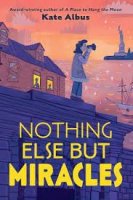What made workers in the American South so tired and feeble during the 19th and early 20th centuries? This exciting medical mystery uncovers the secrets of the parasite hookworm, commonly known as the “American Murderer,” and is the latest title in Gail Jarrow’s (YALSA Excellence in Nonfiction for Young Adults award-winning author) Medical Fiascoes series.
Imagine microscopic worms living in the soil. They enter your body through your bare feet, travel to your intestines, and stay there for years sucking your blood like vampires. You feel exhausted. You get sick easily. It sounds like a nightmare, but that’s what happened in the American South during the 1800s and early 1900s.
Doctors never guessed that hookworms were making patients ill, but zoologist Charles Stiles knew better. Working with one of the first public health organizations, he and his colleagues treated the sick and showed Southerners how to protect themselves by wearing shoes and using outhouses so that the worms didn’t spread. Although hookworm was eventually controlled in the US, the parasite remains a serious health problem throughout the world. The topic of this STEM book remains relevant and will fascinate readers interested in medicine, science, history—and gross stories about bloodsucking creatures.---from the publisher
160 pages 978-1684378159 Ages 10-17
Keywords: American history, 19th century, 20th century, medicine, death and dying, parasites, STEM, Science Curriculum, zoologist, public health, narrative nonfiction, 10 year old, 11 year old, 12 year old, 13 year old, 14 year old
*************
“Bloodsuckers how can they sleep at night
Bloodsuckers nothing but parasites”
– Judas Priest (2001)
“A new study has uncovered a community of people infected with hookworm in Alabama. The study, published this month, found that 19 of 55 individuals tested positive for the worm.
‘I was very surprised by this,’ says Dr. David Diemert, a hookworm expert at George Washington University. ‘There has not been any documentation of people being infected in the U.S. for the past couple of decades; we thought there was no more local transmission in the U.S.’
How is it possible?
Lowndes County, Alabama, is one of the poorest counties in the U.S. — so poor that many residents lack proper sewage systems. Unable to afford a septic system, residents concoct their own sewer line using PVC piping, the researchers observed. The pipe runs from the toilets in their homes and stretches off some 30 feet above ground until it reaches a small ditch.
‘This seems safe to [the residents],’ says Dr. Rojelio Mejia, a pediatrician and infectious disease specialist at the Baylor College of Medicine who led the hookworm study. ‘But Alabama is very hilly and any drizzle of rain causes flooding, so whatever they deliver to the site spreads to the entire area, including their neighbors' area.’
The soil in the area, Mejia adds, also drains poorly, worsening the situation.
When the trenches overflow, the soil becomes contaminated with waste. Anyone walking outside barefoot, or even with bare ankles, risks hookworm infection — that's because the worms are expert at latching on to passers-by.”
– “The U.S. Thought It Was Rid Of Hookworm. Wrong” npr.org (2017)
“By the end of the 1890s, nobody had figured out how Ancylostoma duodenale entered the human body. Researchers demonstrated that swallowing hookworm eggs would not infect a person. Scientists didn’t know when and where a larva transformed into the adult hookworm that spent its life feeding on the small intestine wall. [Arthur] Looss wanted answers to these mysteries.
Working in his Cairo lab in 1898, he mixed hookworm eggs into feces and soil. After a few days, Looss saw thousands of tiny Ancylostoma larvae on the soil surface, waving back and forth. He continued experiments with the larvae to learn more.
One day he clumsily spilled a drop of water filled with hookworm larvae on his hand. The water rolled off but Looss’s skin burned and turned red. He tried it again with another drop of water and larvae, and his skin reacted the same way.
This time Looss used a scalpel to gently scrape off the remaining moisture from his skin. Then he examined the water under the microscope. Most of the larvae were gone, but they left behind their empty worm skins. Looss realized the living larvae had entered his skin.
Where had they gone once they were inside his body? He began checking his feces for hookworm eggs. If he saw any, it would be proof that adult hookworms were living and mating in his small intestine.
After more than two months, he finally found eggs in his stool. During the period of his experiment, Looss occasionally felt tired. He believed this was further evidence that the hookworms were affecting his body. He treated himself with thymol, and dead adult parasites exited his intestine in his feces.
Looss had exposed a hookworm secret. He demonstrated that larvae penetrated his skin, traveled to his intestine, developed into adults, and produced eggs.”
At the dawn of the twentieth century, more than 80 percent of the rural schools and churches in the South didn’t have outhouses. Barefoot students just wandered out of class into the nearby woods to do their thing–boys on one side of the building and girls on the other. Oh, and they typically attended school barefoot, and would be walking through last month’s composting poop, home to millions of hatched hookworms. Thus, human hookworms were sucking the blood of millions of southerners. In addition to propagating in the bodies of their hosts,,the bloodsuckers would lay more eggs that would pass through people in their poop and hatch, so the larvae were constantly infecting new victims.
Yes, AMERICAN MURDERER is gross! That’s what tween and teens reading this significant piece of science- and history-based nonfiction will undoubtedly report to each other in mock horror.
Like COVID today, human hookworms were a major medical and quality of life issue back then. In the early 1900s, some three million Americans were estimated to be inhabited by these blood-sucking parasites. The pests could not survive in the cold of the northern states, so this health epidemic was primarily an issue in the southern states.
Fortunately, an American named Charles Wardell Stiles went to Europe and studied parasites there. He subsequently taught students like the aforementioned Arthur Looss about hookworms in humans. Stiles discovered that the hookworms in the American South were a different species than those he’d studied in Europe. The title of the book–AMERICAN MURDERER–is a literal translation of the Latin name for the parasites present in the U.S.
Once scientists and doctors understood how to diagnose the problem by examining stool samples for hookworm eggs, it was easy to diagnose and cure a victim. Administered orally, Thymol, a constituent of oil of thyme, would kill those bloodsuckers. Patients would soon be excreting dead worms and feeling much better.
The far more complicated aspect of ending the epidemic involved breaking the cycle of infection, and that required improving sanitation. Fortunately, the petroleum barons and philanthropists, the Rockefellers, poured money into educating people and improving sanitary facilities. (Don’t you wish more of today’s billionaires were equally philanthropic?)
I suspect that most adults are as unaware of this critter’s history as I was. Author Gail Jarrow has done an outstanding research job, which she presents in an entertaining, easy-to-follow style. She imparts a quality and quantity of (truly gross) information that will keep grownups reading as raptly as the intended tween and teen audience.
Recommended by: Richie Partington, MLIS, California USA
See more of Richie's Picks <https://richiespicks.com/> https://richiespicks.pbworks.co






